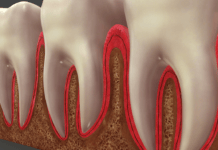February is designated Children’s Oral Health Month in the dental community. Children’s Oral Health Month places emphasis on educating parents and children on the importance of children’s oral health. As part of the celebration, dental professionals and dental supply companies focus on oral health care prevention and preparation for the challenges facing children’s oral health.
Caries is the most preventable disease known to man; however, it is a growing concern to our children. Caries, also known as tooth decay or cavities, “is a chronic, infectious disease resulting from the interaction of sugar, bacteria and tooth enamel.” Caries in children, ages six through eleven, is prevalent in about twenty–one percent of the U.S. population in this age group.1
Caries among young children is referred to as “baby bottle decay” due to children being put to bed with a bottle of milk, formula, or juice. These beverages are high in sugars and react with caries-producing bacteria, typically causing decay on the front teeth. However, early childhood caries is not only caused by sugary beverages but may be the result of the lack of good oral hygiene care, the absence of fluoride, certain medications, developmental defects, and sugary snacks.1
The principles for the dental health care professional to implement to educate parents on early childhood caries are as follows:
- Establish a dental care provider at age one or first tooth eruption
- Establishing a low caries dietary plan
- Establishing good oral home care habits
- Understanding the signs and symptoms of tooth pain and decay
- Implementing care for special needs and healthy teeth
The American Academy of Pediatric Dentistry (AAPD) and the American Dental Association (ADA) recommends children should be seen by a dentist after the eruption of the child’s first tooth or by the child’s first birthday.1 Most general dentist practices recommend the child’s first visit be around age three, contradicting the recommendation of the AAPD and ADA. The theory of a child being seen by age three is based on the child’s cooperation with and tolerance to the dental visit. Working in pediatric dentistry for five years, it is in my opinion that, regardless of age, the appointment can be successful if coordinated to each child’s need.
The first dental visit is important to establish a non-threatening relationship with the child and parents. Aside from polishing the child’s teeth through means of a prophy-cup or toothbrush, the application of fluoride is important to the reduction of the risk to early childhood caries. Studies have indicated an in-office fluoride application two times per year can reduce caries by approximately forty percent in infants and children.2
Another benefit of a dental visit at age one is to educate the parents on the importance of good nutrition. The ADA encourages parents to provide their children with a balanced diet in accordance with the Dietary Guidelines outlined by the U.S. Department of Health and Human Services and the U.S. Department of Agriculture.3 To limit the risk of caries is understanding how sugar plays a role in acid production. By reducing fermentable sugars, the risk of the interaction of the sugar with the bacteria present in the saliva will reduce caries production. The duration of sugary beverages and food in the mouth play a key role in the caries reduction. Limiting snacking to a maximum of three times a day and sugary beverages to meal times will reduce the bacteria-sugar reaction.
Taking the time to sufficiently brush your child’s teeth is an important step to reducing caries production and formulating positive future oral habits. Discussing the importance of tooth brushing duration (at least two minutes) and quantity (twice per day), with the parents, is an important step to establishing good oral home care. The statistics for school-aged children’s decay in ages ranging from nine to eleven is almost twice as high as school-aged children aged six to eight.1 Educating parents in good oral home care habits will, in turn, establish a healthy, long-term dental care regimen for the child.
Also, educating parents on the signs and symptoms of a toothache can be vital to tooth loss prevention in the early developmental years. Toothache in young children and infants can often be mistaken for tooth eruption or “teething.” Roughly thirty-one percent of parents rank toothaches as the least serious ailment in comparison to stomach aches, earaches, headaches, and sore throats.1 In addition, pain management can be an obstacle when treating children and infants because of the lack of communication from the children in determining pain level.
Another obstacle is the long-term effects of pain management due to toxicity and proper dosage. Treatment recommendations can also pose a problem in determining the extent of treatment needed to eliminate the threat of future problems. Over-treatment and under-treatment can be detrimental to the child’s future for various reasons, such as the need for orthodontics, caries progression resulting in monetary damages, and the long-term effect it may have on the child’s negative perception of future dental visits.
It is important for the dental health care provider to understand any medical or developmental condition which may affect the child’s oral care habits or limitations. Tolerance to dental visits at an early age may be an underlying concern for a parent or caregiver. Adapting the dental visit to the child’s special needs may alleviate any predisposed concern the parent may have. Pediatric dentists may also be a recommendation to meet a special needs child’s specific tolerance because of the dentist’s specialized training in addressing dental anxiety.
Thankfully, Children’s Oral Health Month was adopted to bring awareness to the importance of early preventative dental care for children. In a society where education is essential, Children’s Oral Health Month is a positive way for dental professionals to reach out to teachers and parents and explain the importance of educating our children on implementing good dental habits.
References
- American Academy of Pediatric Dentistry. Mouth Monsters-The State of Little Teeth: Second Edition. Retrieved from http://mouthmonsters.mychildrensteeth.org/the-state-of-little-teeth-second-edition
- C.C., Marinho, V.C.C, Worthington, H.V., Walsh, T., Clarkson, J.E. (2013). Fluoride varnishes for preventing dental caries in children and adolescents. Cochrane Library; July 11, 2013. Retrieved from https://www.cochranelibrary.com/cdsr/doi/10.1002/14651858.CD002279.pub2/full
- American Dental Association. Statement on Early Childhood Caries. Retrieved from https://www.ada.org/en/about-the-ada/ada-positions-policies-and-statements/statement-on-early-childhood-caries












